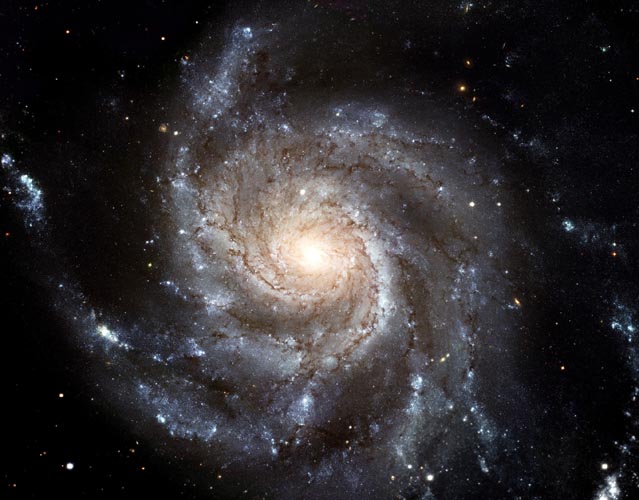
Offers a New High-Definition View
Face-on Spiral Galaxy
R.A. 14h 03m 13s Dec. +54° 20' 53"
Ursa Major
25 million light-years (8 Megaparsecs)
ACS/WFC, WFPC2
March 1994, September 1994, June 1999,
November 13-16, 2002, and January 2003
6.5 hrs
NASA, ESA, and The Hubble Heritage Team (STScI/AURA)
February 28, 2006
Composite image: G1205cx Closeup image: G0610b
ABOUT THIS IMAGE:
Giant galaxies weren't assembled in a day. Neither was this Hubble Space Telescope image of the face-on spiral galaxy Messier 101 (M101). It is the largest and most detailed photo of a spiral galaxy that has ever been released from Hubble. The galaxy's portrait is actually composed of 51 individual Hubble exposures, in addition to elements from images from ground-based photos. The final composite image measures a whopping 16,000 by 12,000 pixels.
The Hubble archived observations that went into assembling this image were originally acquired for a range of Hubble projects: determining the expansion rate of the universe, studying the formation of star clusters in the giant star birth regions, finding the stars responsible for intense X-ray emission, and discovering blue supergiant stars.
The giant spiral disk of stars, dust, and gas is 170,000 light-years across or nearly twice the diameter of our galaxy, the Milky Way. M101 is estimated to contain at least one trillion stars. Approximately 100 billion of these stars could be like our Sun in terms of temperature and lifetime.
The galaxy's spiral arms are sprinkled with large regions of star-forming nebulae. These nebulae are areas of intense star formation within giant molecular hydrogen clouds. Brilliant young clusters of hot, blue, newborn stars trace out the spiral arms. The disk of M101 is so thin that Hubble easily sees many more distant galaxies lying behind the galaxy.
M101 (also nicknamed the Pinwheel Galaxy) lies in the northern circumpolar constellation, Ursa Major (The Great Bear), at a distance of 25 million light-years from Earth. Therefore, we are seeing the galaxy as it looked 25 million years ago - when the light we're receiving from it now was emitted by its stars - at the beginning of Earth's Miocene Period, when mammals flourished and the Mastodon first appeared on Earth. The galaxy fills a region in the sky equal to one-fifth the area of the full moon.
The newly composed image was assembled from Hubble archived images taken with the Advanced Camera for Surveys and the Wide Field and Planetary Camera 2 over nearly 10 years: in March 1994, September 1994, June 1999, November 2002, and January 2003. The Hubble exposures have been superimposed onto ground-based images, visible at the edge of the image, taken at the Canada-France-Hawaii Telescope in Hawaii, and at the 0.9-meter telescope at Kitt Peak National Observatory, part of the National Optical Astronomy Observatory in Arizona. The final color image was assembled from individual exposures taken through blue, green, and red (infrared) filters.
Filters: F435W(B), F555W(V), F814W(I)